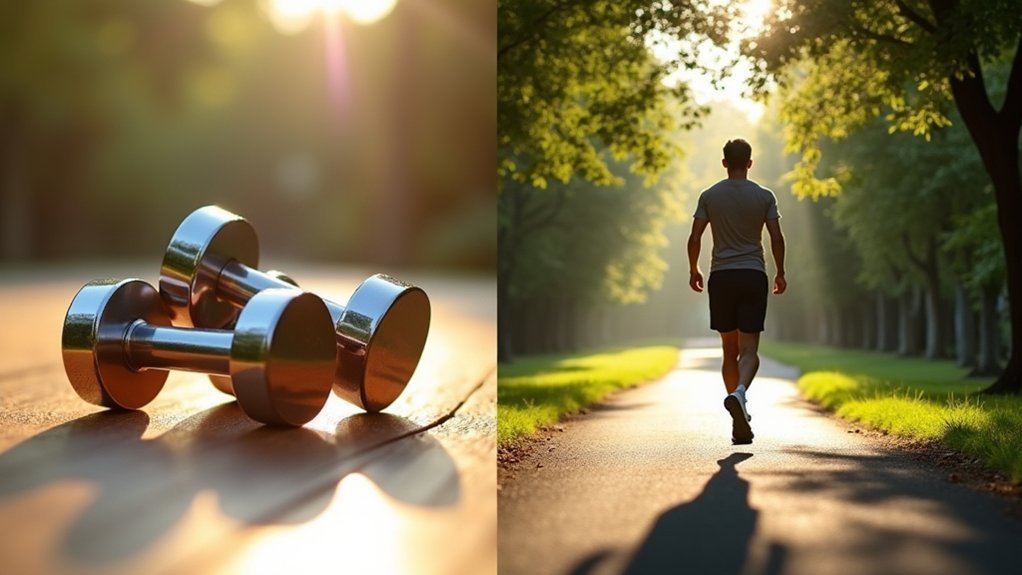Mini exercises create 2-4 times more impact force on bones than walking, delivering significant benefits in just 10-15 minutes versus walking’s required 21-42 minutes daily. While walking primarily loads bones in one direction, mini exercises provide multi-directional forces that better stimulate bone formation. For best results, combine both: quick mini sessions for intensity and walking for foundational strength. Discover how this powerful combination can transform your bone health strategy.
Understanding Walking’s Impact on Bone Density

When it comes to strengthening your skeletal framework, walking emerges as an accessible yet powerful exercise option.
To effectively improve bone density, especially in your hip and femoral neck regions, you’ll need to maintain a brisk pace of 2.5 to 3.7 miles per hour, achieving at least 120 steps per minute.
Research shows that breaking up your walking routine into shorter, frequent sessions of 21 to 42 minutes daily yields better results for bone density than single extended walks.
While meta-analyses confirm walking’s positive effects on bone density in specific areas, upper body benefits remain less conclusive.
Don’t expect immediate results—noticeable improvements in bone density typically require six months or more of consistent effort, making regular walking a long-term investment in your skeletal health.
Mini Exercise: The Bone-Strengthening Powerhouse
Although walking offers many skeletal benefits, mini exercises stand out as true bone-strengthening powerhouses. These short-burst workouts, including HIIT and resistance training, deliver significant weight-bearing impact that directly stimulates bone renewal and improves density.
You’ll find mini exercise routines particularly valuable if you’re time-constrained, as they provide substantial bone health benefits in compressed timeframes. Unlike moderate walking, these workouts create higher impact forces and resistance that your skeletal system needs for meaningful strengthening.
Research shows mini exercises can specifically improve bone density in critical areas like the hip and femoral neck—regions most vulnerable to osteoporosis. The varied movements engage multiple muscle groups simultaneously, enhancing your stability and reducing fall risks.
For effective bone strengthening, incorporating these powerful mini routines into your schedule offers advantages walking alone can’t match.
Measuring Impact Forces: Mini Exercises vs. Walking

When you perform mini exercises like jumps or hops, your bones experience impact forces 2-4 times greater than those generated during walking.
Scientists measure these skeletal impacts using specialized force plates and wearable accelerometers that capture the precise magnitude of stress applied to your bones.
Your body responds more vigorously to these higher-impact forces, triggering the bone-building processes that strengthen your skeletal structure more effectively than walking alone.
Force Variations Explained
Measuring the impact forces between mini exercises and walking reveals notable differences in bone-strengthening potential.
When you walk at a brisk pace (2.5-3.7 mph), your bones experience moderate, consistent force levels that provide some benefit but limited stimulus for bone growth.
Mini exercises, however, create high-impact force variations that more effectively trigger bone density improvements. These weight bearing exercises produce explosive forces during activities like jumping, creating the mechanical stress your skeletal system needs to develop stronger bones.
The varied impact patterns stimulate bone-forming cells more intensely than walking’s uniform pressure.
For individuals concerned about osteoporosis, this distinction matters markedly. While walking contributes to overall health, the dynamic force variations in mini exercises deliver superior results for maintaining and improving bone strength in vital weight-bearing areas.
Impact Measurement Techniques
How exactly do scientists quantify the bone-strengthening potential of different activities? They use specialized force plates that measure ground reaction forces—the impact your body experiences during different types of exercise.
These devices reveal that walking typically generates forces of 1.0-1.5 times your body weight, while mini exercises like jumping or hopping can produce forces exceeding 3.0 times your body weight.
Researchers also employ accelerometers to track the frequency and duration of impacts, showing how mini exercises deliver sudden, controlled stress that stimulates bone remodeling more effectively than walking’s moderate impact.
Advanced imaging techniques then confirm these findings by measuring changes in bone mineral density, particularly in the hip and spine regions, where mini exercises consistently outperform walking for bone strengthening benefits.
Directional Loading: Why It Matters for Bone Formation
The way you stress your skeletal system directly impacts how effectively your bones strengthen and rebuild. Directional loading—applying forces from various angles—triggers bone formation processes essential for maintaining bone density. When you engage in mini-trampoline exercises, you expose your skeleton to multidirectional forces that walking simply can’t provide.
| Loading Type | Mini-Trampoline | Walking |
|---|---|---|
| Vertical | High impact bouncing | Moderate foot strikes |
| Lateral | Side-to-side movements | Limited side motion |
| Rotational | Twisting jumps | Minimal rotation |
| Multi-angle | 360° movement potential | Primarily forward motion |
| Variable | Adjustable intensity | Consistent loading |
Your bones respond most favorably to diverse loading patterns. By incorporating exercises that challenge your skeleton from multiple directions, you’ll stimulate more thorough bone adaptation than single-plane movements alone can accomplish.
Time Efficiency: Comparing Exercise Duration Requirements

When juggling your busy schedule, finding time for bone-strengthening activities often becomes a challenge. Mini exercises offer a time-efficient solution, requiring only 10-15 minutes per session to effectively build bone strength through short, focused activity bursts.
Walking, while beneficial, demands a greater time commitment. You’ll need 21-42 minutes daily or 150-300 minutes weekly at a brisk pace (at least 2.5 miles per hour) to see significant bone density improvements. This longer duration means more scheduling considerations.
Walking requires commitment: 21-42 minutes daily at a brisk pace to build stronger bones and improve density.
The flexibility of mini exercises allows you to integrate multiple short sessions throughout your day, adapting intensity based on your capabilities.
In contrast, walking’s effectiveness relies on sustained effort over longer periods. Your choice ultimately depends on which exercise duration requirement better fits your lifestyle while still prioritizing your bone health.
Balance and Fall Prevention Benefits Compared
When you practice mini exercises like tai chi or single-leg stands, you’ll develop better stability through movement patterns that walking alone can’t provide.
Your reaction time will improve more markedly with balance-specific training, helping you recover quickly when you stumble or encounter an unexpected obstacle.
Both exercise types enhance proprioception (your body’s position awareness), but targeted mini exercises train this sensory system more effectively than walking by challenging your body to maintain balance in varied positions.
Stability Through Movement
Balance and stability, often overlooked aspects of bone health, play essential roles in preventing falls that can lead to fractures. Your body’s proprioception—awareness of position and movement—improves greatly through consistent practice of balance exercises alongside regular walking routines.
When you walk briskly (3.1-3.7 mph), you’re not just building bone density; you’re training your body in coordinated movement as your arms and legs work in harmony. Research shows combining walking with targeted balance training yields better stability improvements than walking alone.
For those with osteoporosis, mini-exercise routines focused on balance create double benefits: strengthening bones while reducing fall risk.
Reaction Time Improvements
As aging progresses, your ability to react quickly to unexpected obstacles becomes increasingly essential for preventing falls and fractures.
Both mini exercises and walking offer distinct advantages for enhancing your reaction time while helping maintain your bone health.
Mini exercises deliver immediate benefits through:
- Quick movement bursts that sharpen reflexes and coordination
- Targeted strength-agility combinations improving response to potential hazards
- Enhanced proprioception for better body position awareness
Walking at a brisk pace (2.5-3.7 mph) steadily improves your stability and coordination over time.
When you combine both exercise types, you’ll experience synergistic improvements to your reaction time, creating a thorough approach to fall prevention.
This combination builds confidence in your movements and enhances safety during everyday activities—crucial factors in protecting your skeletal system as you age.
Proprioception Training Differences
Since your brain constantly monitors your body’s position in space, proprioception training becomes an essential difference between mini exercises and walking routines.
Mini exercises typically include targeted balance exercises like single-leg stands and stability ball activities that specifically challenge your proprioceptive system, while walking provides a more general stimulus.
The distinction matters, especially if you have osteoporosis. Mini exercises can deliver a 30% greater reduction in fall risk compared to walking alone because they deliberately develop neuromuscular control.
When you practice yoga or tai chi as part of mini-exercise routines, you’re training your body to respond effectively to uneven surfaces and unexpected terrain changes.
Walking improves overall fitness, but dedicated proprioception training through mini exercises offers superior benefits for coordination, stability and fall prevention during daily activities.
Creating an Optimal Bone-Building Exercise Regimen
To maximize your bone health, a well-designed exercise program should combine multiple activity types rather than relying on a single approach. Weight-bearing activities like brisk walking (2.5-3.7 mph) should form your foundation, with research showing these activities notably contribute to increased bone density.
For best results, structure your routine with:
- Frequent shorter walks (21-42 minutes daily) rather than one extended session, totaling 150-300 minutes weekly
- Resistance training 2-3 days weekly, progressively increasing weight as you strengthen
- Movement variety incorporating different directions and speeds, such as dancing or circuit training
Don’t forget to include high-impact exercises if appropriate for your risk level.
The combination of varied activities challenges your skeletal system more effectively than any single exercise type, creating thorough bone-strengthening benefits.
Adapting Exercises for Different Osteoporosis Stages
Developing an effective exercise program requires careful adaptation based on your osteoporosis stage and individual health status. Your workout regimen should evolve as your condition changes to maximize bone health while preventing injury.
| Stage | Recommended Exercises | Focus Areas |
|---|---|---|
| Early | Mini-resistance training with bands, brisk walking | Stimulate bone renewal, minimize bone loss |
| Intermediate | Power walking, moderate strength training | Balance improvement, fall prevention |
| Advanced | Low-impact mini-exercises, seated movements | Posture maintenance, stability |
For best results, combine weight-bearing activities with appropriate strength training regardless of your stage. Early detection allows for more aggressive approaches, while advanced cases require gentler modifications. Regular assessments help guarantee your routine remains safe and effective as your condition progresses, allowing you to continuously support bone health.
Frequently Asked Questions
Does Walking Increase Bone Strength?
Yes, walking can increase your bone strength, but you’ll need to maintain a brisk pace (at least 2.5 mph or 120 steps per minute) to effectively improve bone density, especially in your hips and femoral neck.
Is Walking the Best Exercise for Bone Strength and Integrity?
No, walking isn’t the best exercise for bone strength. You’ll get better results from high-impact activities, resistance training, and balance exercises. Walking helps somewhat but should be complemented with more intense bone-loading movements.
Which Activity Strengthens Bones the Most?
High-impact activities strengthen bones the most. You’ll get better results from jumping, dancing, or resistance training than walking alone. Combining these with your walks creates an ideal routine for building bone density.
What Is the Best Exercise to Increase Bone Density?
To best increase bone density, you’ll need weight-bearing exercise plus resistance training. Walk briskly at 3.1-3.7 mph (120 steps/minute) and add strength training 2-3 days weekly for ideal bone health results.
In Summary
You’ll gain more bone strength through mini exercises than walking alone, thanks to their higher impact forces and multidirectional loading. While walking provides important weight-bearing benefits, combining both approaches creates an ideal regimen. By dedicating just minutes to daily mini exercises alongside your regular walks, you’ll maximize bone density, improve balance, and reduce fracture risk regardless of your current bone health.





Leave a Reply